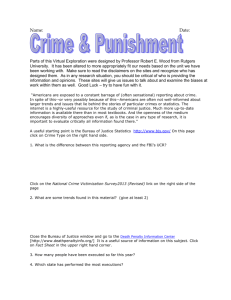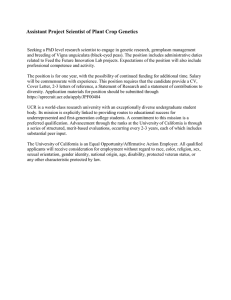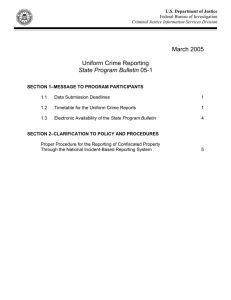April 2007 Uniform Crime Reporting (UCR) State Program Bulletin
advertisement
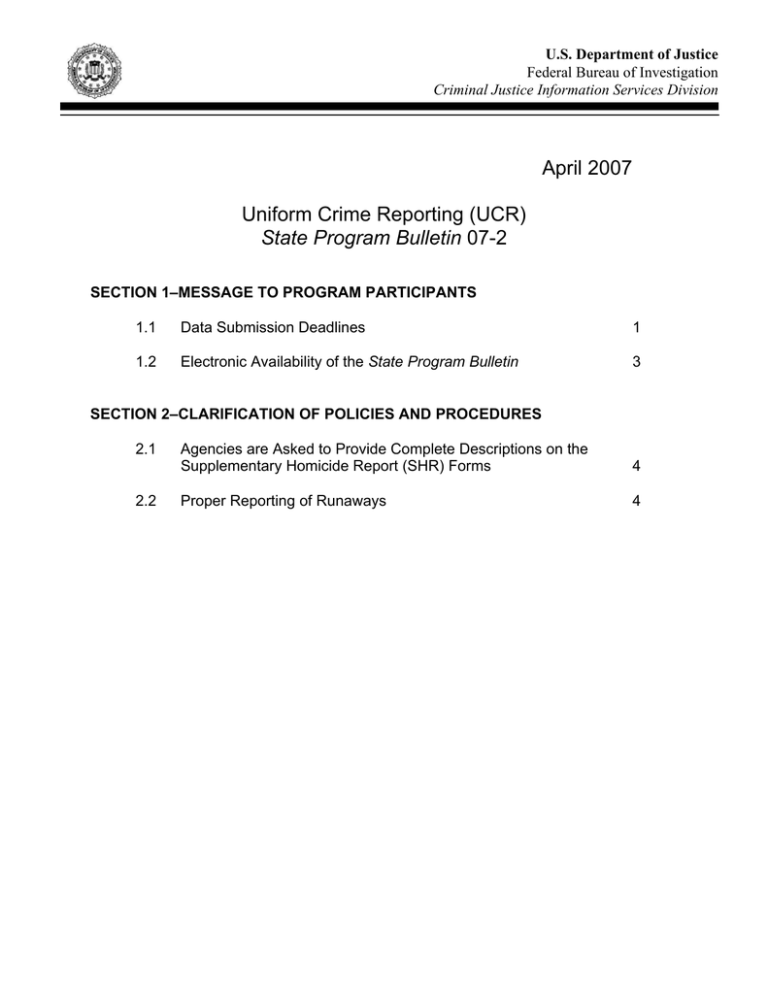
U.S. Department of Justice Federal Bureau of Investigation Criminal Justice Information Services Division April 2007 Uniform Crime Reporting (UCR) State Program Bulletin 07-2 SECTION 1–MESSAGE TO PROGRAM PARTICIPANTS 1.1 Data Submission Deadlines 1 1.2 Electronic Availability of the State Program Bulletin 3 SECTION 2–CLARIFICATION OF POLICIES AND PROCEDURES 2.1 2.2 Agencies are Asked to Provide Complete Descriptions on the Supplementary Homicide Report (SHR) Forms 4 Proper Reporting of Runaways 4 SECTION 1–MESSAGE TO PROGRAM PARTICIPANTS 1.1 Data Submission Deadlines Preliminary Annual Uniform Crime Report, 2006 Crime in the United States (CIUS), 2006 Law Enforcement Officers Killed and Assaulted (LEOKA), 2006 Hate Crime Statistics, 2006 Preliminary Semiannual Uniform Crime Report, January–June, 2007 As part of the FBI’s effort to keep state UCR Programs informed about data submission deadlines and UCR publication processes, we have included the following schedule. In order for the FBI to publish these Uniform Crime Reports on time with complete and accurate statistics, all states must adhere to the scheduled deadlines. Many agencies are conscientious about meeting these deadlines; however, agencies that are late with their submissions cause publication delays. The FBI realizes that there are always extenuating circumstances that cause an agency to miss a deadline. Nevertheless, the FBI requests that state Program managers encourage the agencies within their state to make every effort to adhere to these deadlines. Date Work Process April The FBI’s Crime Statistics Management Unit (CSMU) disseminates letters to state Program managers providing January–December 2006 crime totals/Return A Record Cards for all law enforcement agencies that submitted 12 months of complete data. June The tentative release of the Preliminary Annual Uniform Crime Report, 2006. June and July The national UCR Program staff reviews information for data quality and finalizes the 2006 editions of CIUS, LEOKA, and Hate Crime Statistics for publication. July The CSMU’s staff disseminates letters to state Program managers requesting missing January–June 2007 data for Most-in-Population (MIP) agencies that are to be included in Table 4 of the Preliminary Semiannual Uniform Crime Report, January–June, 2007. The letters will provide the August 31, 2007, deadline for submitting data to be included in the Preliminary Semiannual Uniform Crime Report. The deadline for submitting January through June 2007 data to the FBI for inclusion in the Preliminary Semiannual Uniform Crime Report is August 31, 2007. UCR State Program Bulletin 07-2 1 April 2007 August and September The CSMU’s staff disseminates letters to state Program managers: • Requesting verification of any January–June 2007 crime totals that indicate significant increases or decreases over the previous year’s data and/or verification of any high/low monthly offense counts during the 6-month period for MIP agencies. The deadline for submitting January through June 2007 data to the FBI for inclusion in the Preliminary Semiannual Uniform Crime Report is August 31, 2007. September The CSMU’s staff disseminates letters to state Program managers: • Identifying any missing January–June 2007 data that the FBI has not received by the submission deadline for the Preliminary Semiannual Uniform Crime Report to all contributors other than MIP agencies. • Seeking follow-up from MIP agencies that did not respond to trend letters. (The CSMU’s staff may opt to contact these agencies via telephone.) • Requesting verification of any January–June 2007 crime totals that indicate significant increases or decreases over the previous year’s data and/or verification of any high/low monthly offense counts during the 6-month period for all contributors other than MIP agencies that submitted 3 or more months of data. The tentative release of CIUS, 2006. October The CSMU’s staff disseminates letters to state Program managers: • Requesting verification of any January–June 2007 crime totals that indicate significant increases or decreases over the previous year’s data and/or verification of any high/low monthly offense counts during the 6-month period for all contributors other than MIP agencies that submitted 3 or more months of data. • Requesting the completion of information on the current year’s police employee counts as of October 31, 2007. The deadline for submitting police employee counts is December 21, 2007. The tentative release of LEOKA, 2006, and Hate Crime Statistics, 2006. UCR State Program Bulletin 07-2 2 April 2007 November The CSMU’s staff disseminates letters to state UCR Program managers requesting a review of the Population-by-County printout to verify the current reporting status of each agency and to identify any new agency contributors. The CSMU’s staff disseminates a State Program Bulletin reminding all state Program managers of the December 31, 2007, deadline for making changes to an agency’s name/address or current reporting status. (The CSMU’s staff will not assign an Originating Agency Identifier until an agency submits one Return A form.) December The national UCR Program staff publishes the Preliminary Semiannual Uniform Crime Report, January–June, 2007. Prior to the December 21, 2007, deadline, the CSMU’s staff will forward letters to state Program managers informing them that the FBI has not received their police employee counts. The deadline for submitting police employee counts is December 21, 2007. The deadline for making changes to an agency’s name/address or current reporting status is December 31, 2007. 1.2 Electronic Availability of the State Program Bulletin The UCR Program’s State Program Bulletin is available electronically in Corel WordPerfect and Microsoft Word formats. State Program managers who wish to receive the State Program Bulletin via e-mail instead of receiving hard copies through the U.S. Postal Service should provide the CSMU’s staff at the FBI’s CJIS Division with their e-mail address at <cjis_comm@leo.gov> and indicate State Program Bulletin in the subject line of the e-mail. Please note that whether the State Program Bulletin is received electronically or in hard copy, it is the responsibility of the state UCR Program manager to disseminate the information as appropriate to their staff and local agencies. In order to serve our customers in the best manner possible, the national UCR Program would like to remind state Program managers to keep the CSMU informed of any changes in their e-mail addresses. The current State Program Bulletin, as well as previous editions, is also available via the Law Enforcement Online (LEO) Intranet at <www.leo.gov/special_topics/stats/stats_home.html> (under Crime in the U.S.: Uniform Crime Reports Section). Users with questions concerning access to the LEO should contact the LEO Program Office at (202) 233-9283 (telephone) or Mrs. Stacey C. Davis of the Advisory Groups Management Unit at (304) 625-2618 (telephone). UCR State Program Bulletin 07-2 3 April 2007 SECTION 2–CLARIFICATION OF POLICIES AND PROCEDURES 2.1 Agencies are Asked to Provide Complete Descriptions on the Supplementary Homicide Report (SHR) Forms Many times, the FBI receives Supplementary Homicide Report (SHR) data with the weapon used data as unknown and the circumstance as blunt force. The CSMU’s staff is unable to complete these categories on the SHR because the information is too vague. When a law enforcement agency completes a hard copy of the SHR, the reporting agency should provide the most complete description possible of the weapon used. If a weapon was used that could be employed in several ways during the commission of a homicide, the agency should state exactly how the weapon was used. In addition, when an agency reports the circumstance of the homicide on the SHR, the agency should furnish a brief statement regarding the circumstance of the victim’s death. If a murder occurred in conjunction with the commission of another felony such as a forcible rape or robbery, the reporting agency should identify the specific offense involved. In other criminal homicides, the reporting agency should include as much information as possible so that the national UCR Program staff can identify those murders resulting from lovers’ quarrels, drunkenness, arguments over money, revenge, etc. Information about the proper reporting of the weapon used and the circumstance of a murder on the SHR is provided on pages 106 and 107 of the Uniform Crime Reporting Handbook (2004). Agencies with questions on these matters should contact the UCR Outreach Team at (888) 827-6427. 2.2 Proper Reporting of Runaways Being a runaway does not constitute a criminal offense in the UCR Program; however, the FBI collects data so that law enforcement agencies can review the handling of runaways. Law enforcement agencies should report the handling of runaways under the age of 18 regardless of whether the incident is reported via the Summary system (as a Part II offense) or the National Incident-Based Reporting System (as a Group B offense). For UCR purposes, missing persons should not be reported as runaways unless the reporting agency determines that the person under the age of 18 ran away and is not missing. Agencies with questions about this matter should contact the UCR Outreach Team at (888) 827-6427. UCR State Program Bulletin 07-2 4 April 2007
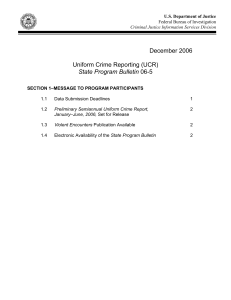
![[ B T ]](http://s2.studylib.net/store/data/010883523_1-c407e81017a0b28f1aa4830294f9d7e5-300x300.png)
